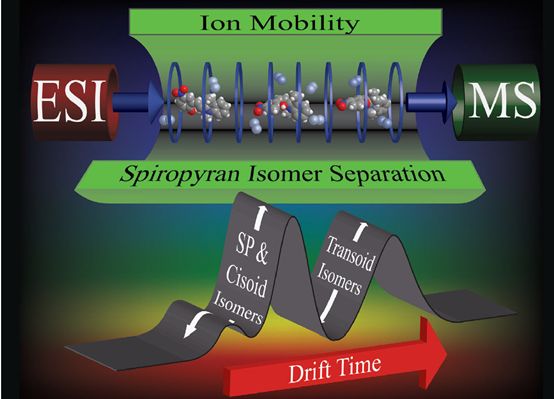分子尺度实验室研究方向集中在质谱表征, 配位键自组装超分子化学和超分子材料,具体包括:
(1) 利用多臂配体设计、合成巨型超分子,提供更多几何约束以防止多个实体形成并达到最稳定的热力学结构;
(2) 通过组装前或组装后的修饰将多种官能团结合到超分子核心结构中;
(3) 使用质谱法表征超分子,例如基质辅助激光解吸(MALDI)、电喷雾电离(ESI)和离子迁移质谱(IM-MS);
(4) 探索超分子在多领域的应用,例如主体−客体化学,分子识别,反应性调节,催化,模板合成和生物学。
代表方向:
Introducing Seven Transition Metal Ions into Terpyridine-Based Supramolecules
In terpyridine(tpy)-based supramolecular chemistry, the metal ions used to construct large discrete structures through direct self-assembly were mainly limited to three metal ions with highly reversible coordination, viz., Cd(II), Zn(II), and Fe(II). In this study, we significantly broaden the spectrum of metal ions with seven divalent transition metal ions M(II) (M = Mn, Fe, Co, Ni, Cu, Zn, Cd) to assemble a series of supramolecular fractals. In particular, Mn(II), Co(II), Ni(II), and Cu(II) were reported for the first time to form such large and discrete structures with ⟨tpy-M-tpy⟩ connectivity. Instead of building new structure, we studied the structural stabilities of those supramolecules in the gas phase and the kinetics of the ligand exchange process in solution using mass spectrometry. Such a fundamental study gave the relative order of structural stability in the gas phase and revealed the inertness of coordination in solution depending on the metal ions. Those results would guide the future study in tpy-based supramolecular chemistry in terms of self-assembly, characterization, property, and application. See our recent paper on JACS. (J. Am. Chem. Soc., 2020, 142, 1811-1821)

Push Forward of Pyrylium Salts and Pyridinium Salts Chemistry into 3d Structures
In the journey of exploring pyrylium salts and pyridinium salts chemistry, all the complex supramolecules we built were limited to 2D structures. Heng advanced the chemistry into 3D structure through using pentatopic terpyridine ligands to assemble two giant supramolecular hexagonal prisms, MW 42608 and 43569 Da (J. Am. Chem. Soc., 2019, 141, 16108-16116). Within the prisms, two double-rimmed Kandinsky Circles serve as the base surfaces as well as the templates for assisting the self-sorting during the self-assembly. These supramolecular prisms show good antimicrobial activities against Gram-positive pathogen methicillin-resistant Staphylococcus aureus (MRSA) and Bacillus subtilis (B. subtilis).
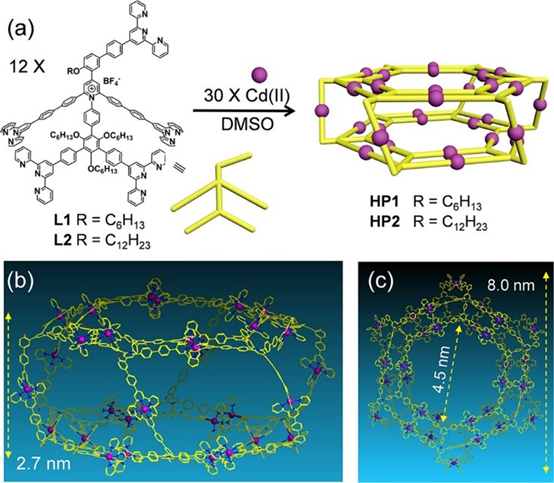
One Pot Strategy for Constructing Complex 2D Metallo-Supramolecules Using Pyrylium Salts and Pyridinium Salts Chemistry
In the past several years, we always synthesized multi-armed organic building blocks for the self-assembly of complex structures with high density of coordination site (DOCS). Many group members complained about the multistep synthesis and tedious separation. Thanks to Heng, we are able to combine synthesis and self-assembly in one pot to construct supramolecular Kandinsky Circles and spiderwebs . (J. Am. Chem. Soc., 2019, 141, 13187).
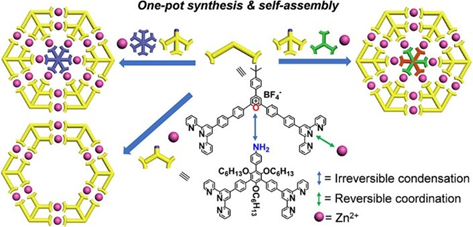
Supramolecular Fractals Assembled by Sequence-Specific Building Blocks

Most of the metallo-supramolecules were constructed with simple building blocks through coordination-driven self-assembly. Even now, using simple building blocks to construct complex structures with similar complexity as Nature does is still the mainstream in self-assembly field. Inspired by the complex structure of protein, we attempted to introduce specific sequence into the building blocks of metallo-supramolecules. Please find our generations 1-5 supramolecular fractals with sequence-specific building block (Nat. Commun., 2018, 9, 4575) as well as the story Behind the Paper. Meanwhile, we obtained another series of supramolecular fractal with similar design principle with cover article published on JACS. (J. Am. Chem. Soc., 2018, 140, 12819–12828).

Kandinsky Circles: Self-assembly of Nested Concentric Hexagons


Nested concentric structures widely exist in nature and designed systems with circles, polygons, polyhedra, and spheres sharing the same center or axis. In art field, concentric rings are known as Kandinsky circles named after Wassily Kandinsky, a pioneer in abstract art, because of his prominent and profound painting Color Study-Squares with Concentric Circles. We started Kandinsky Circles project in early 2013. After three years efforts, we assembled four G2 concentric hexagons (J. Am. Chem. Soc., 2016, 138, 9258–9268) however, were unable to reach higher generation because of the challenging synthesis of multitopic terpyridine ligand.
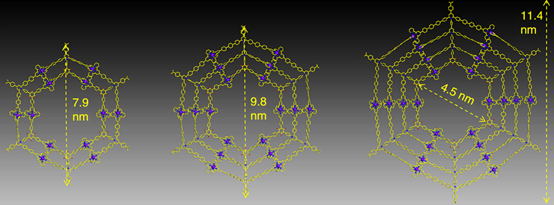
With another two years, we eventually found a solution with consecutive condensation between precursors with primary amines and pyrylium salts. Such modular synthetic approach allows us to prepare multi-armed terpyridine ligand, e.g., octatopic one. Then, three generations (G2−G4) of giant Kandinsky circles were assembled with molecular weight 17,964, 27,713 and 38,352 Da, respectively. Furthermore, such Kandinsky Circles displayed high antimicrobial activity against Gram-positive pathogen methicillin-resistant Staphylococcus aureus (MRSA) through formation of transmembrane channels. Our endeavors will shed light into both antibiotics and supramolecular chemistry field and pave a new avenue into the development and application of antimicrobial agents. (Nat. Commun., 2018, 9, 1815 )
Increasing the Complexity and Tuning the Emission
With the goal of increasing the restriction of intramolecular rotation (RIR) and structural complexity of supramolecules, we designed and synthesized L1-L3 by introducing multiple TPY groups onto tetraphenylethylene (TPE) core. The self-assembly of three generations of giant supramolecules G1-G3 with rosettes-like structures were further introducing additional restriction of intramolecular rotation and immobilize fluorophores. Such supramolecules display tunable emissive properties with respect to different generations, particularly, pure white-light emission. The single-component white light emitter is expected to exhibit superior performance improved stability, good reproducibility, and simple device fabrication procedure compared to those multi-component emitters. The team eventually named those structures as supramolecular rosettes, and hopefully, they can give out a bright light in both supramolecular chemistry and emissive materials community to inspire us to seek more complicated structures with tunable properties. The team was also invited by Nature Communications to write a story Behind the Paper.
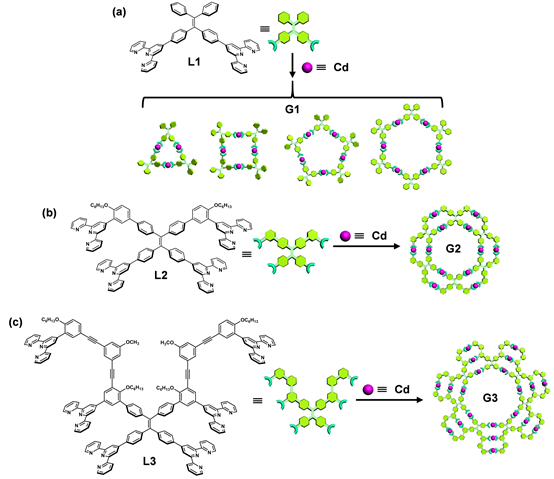

Supersnowflakes
After many years of attempts, we eventually made giant and rigid metallo-supramolecular snowflakes. This is also the first time we were able to combine three terpyridine ligands(multi-components) into one self-assembly system through step-wise approach. In the mixture of two-preassembled snowflakes, we even observed slow dynamic ligand exchange to form many hybrid snowflakes, indicating the great structural tolerance of these snowflakes. For many years, we wanted to publish this paper around Christmas; now it was published in May, Florida, where we have endless summer. Please see our recent paper on JACS.
J. Am. Chem. Soc., 2017, 139, 8174-8185

Star of Texas, 2D Star of David and 3D Star of David
In the collaboration with Prof. Pingshan Wang, we successfully assembled supramolecular hexagram and pentagram using step-wise strategy. We originally named them as Star-of-David (hexagram) and Star-of-Texas (pentagram). Yes, the Star-of-Texas always let us recall Texas, the Lone Star State. Please find our recent publication on Nat. Commun.
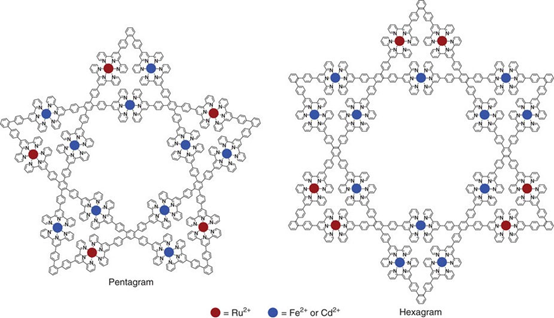
Meanwhile, we also advanced the supramolecular chemistry of Star-of-David from terpyridine-based self-assembly into pyridine-based self-assembly. Instead of using step-wise strategy, we redesigned the ligand and were able to directly assemble 2D Star-of-David with Pt(II)-component in high yield. With the goal of increasing the complexity and stability of supramolecules, for the first time, we obtained a 3D version of Star-of-David, which has four 2D Star-of-David as cross sections. For details, see our recent publication on Angew. Chem. Int. Ed.
Angew. Chem. Int. Ed., 2017,56 ,5258–5262

Hybrid Gel Enabled by Cubic Supramolecules and Nanostructured Polymer with High Conductivity and Self-Healing Ability
In the collaboration with Yu research group at University of Texas at Austin, we developed a hybrid material based on self-assembled supramolecular gel and nanostructured polypyrrole. This hybrid system synergizes the dynamic assembly/disassembly nature of metal–ligand supramolecular cubes and the conductive nanostructure of polypyrrole hydrogel and exhibits features of high conductivity (12 S m–1), appealing mechanical and electrical self-healing property without any external stimuli, and enhanced mechanical strength and flexibility.
Nano Lett., 2015, 15 , 6276–6281
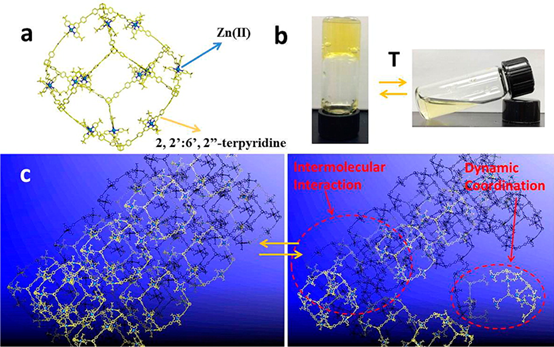
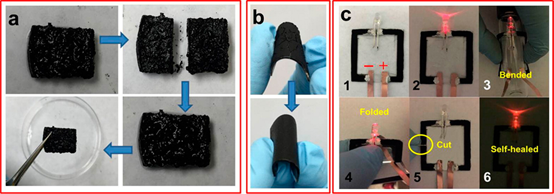
Ring-in-Ring, Sphere-in-Sphere and DOCS
Directed by increasing the density of coordination sites (DOCS) to increase the stability of assemblies, discrete 2D ring-in-rings and 3D sphere-in-sphere were designed and self-assembled by one tetratopic pyridyl-based ligand with 180° diplatinum(II) acceptors and naked Pd(II), respectively. The high DOCS resulted by multitopic ligand provided more geometric constraints to form discrete structures with high stability and complexity. Such sophisticated 2D and 3D structures with multiple subunits are reminiscent to protein tertiary structures, which contain different functional domains. If we introduce different functionality at different subunits, these sophisticated 2D and 3D architectures may perform as proteins with different functional domains, which can never be achieved in regular 2D macrocycles or 3D polyhedrons. We also proposed a quantitative definition of DOCS for 2D and 3D metallo-supramolecular structures.
J. Am. Chem. Soc., 2015, 137, 1556–1564.


Self-assembly and self-sorting study of supramolecular bipyramidal and Platonic solids
Using a series of tritopic 2,2’:6’,2”-terpyridine (tpy) ligands constructed on adamantane, three discrete 3D metallo-supramolecular architectures were assembled, i.e., trigonal bipyramidal, tetrahedron, and cube. The angles of the linkers between adamantane and tpy head play a critical role in guiding the assembled structures, which have the general formula of M3nL2n, where M denotes metal ion and L denotes ligand. And the self-sorting behavior is solely based on the angles precoded within the arm of tritopic ligands. More importantly, these cages may become an excellent system to study host−guest interaction due to their distinct cavity and face window sizes.
J. Am. Chem. Soc., 2014, 136,10499–10507
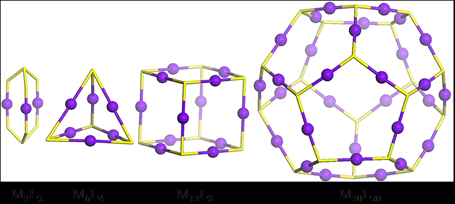

Hexagon wreaths: Self-Assembly of discrete supramolecular fractal architectures using multitopic terpyridine ligands
Conventional self-assembly of macrocycles that uses ditopic 2,2’:6’,2”-terpyridine (tpy) building blocks with a 120°angle between two ligating moieties generally produces a mixture of multiple macrocycles instead of a single hexagon. Precise control over the self-assembly of metallomacrocycles toward discrete structures is still one of the ultimate goals and challenges in the field of supramolecular chemistry. We reason that a system with a high density of coordination sites (DOCS) can provide more geometric constraints to form discrete and thermodynamically stable structures. Based on the principle to increase DOCS, we designed and assembled two fractal architectures by simple recursion of small hexagons around the center hexagon.
J. Am. Chem. Soc., 2014, 136 , 6664–6671.
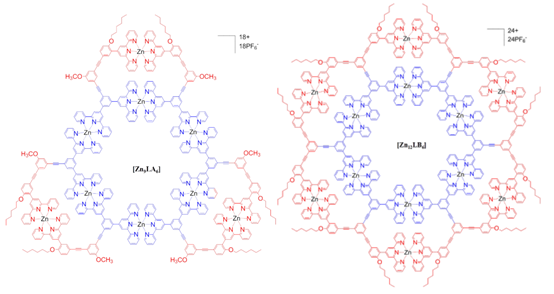
Our first 3D supramolecules based on 2,2’:6’,2”-terpyridine
The construction of 3D architectures using 2,2’:6’,2”-terpyridine (tpy) was very challenging, mainly attributed to the following two reasons: (1) the fixed geometry of tpy-M(II)-tpy connectivity (i.e., 180°) and (2) the synthesis of appropriate organic ligands as directing units in the corners. Therefore, the self-assembly based on tpy was focused on supramolecular polymers, macrocycles, grid array, and 2D architectures. In this study, we utilized tpy-based organic ligands built on adamantane as directing units in the vertices to construct giant 3-D supramolecular cubes possessing highly symmetric structure with metal ions on edges.
Chem. Sci., 2014, 5, 1221-1226

The first experimental evidence for a cisoid merocyanine intermediate in spiropyran photoisomerization on a millisecond timescale
In collaboration with Brittain group, we used electrospray ionization (ESI) ion mobility-mass spectrometry (IM-MS) to study spiropyran photoisomerization, in which three major conformers were identified. This suggests that dynamic behaviour is temporarily “frozen” when the molecules are transferred from solution (thermodynamically controlled) to gas phase (kinetically controlled). The combination of ESI with IM-MS provides additional shapes and sizes information on the structure-dynamics of this important photochromic system. This study was featured as back cover.
Chem. Commun., 2014, 50, 3424-3426.
